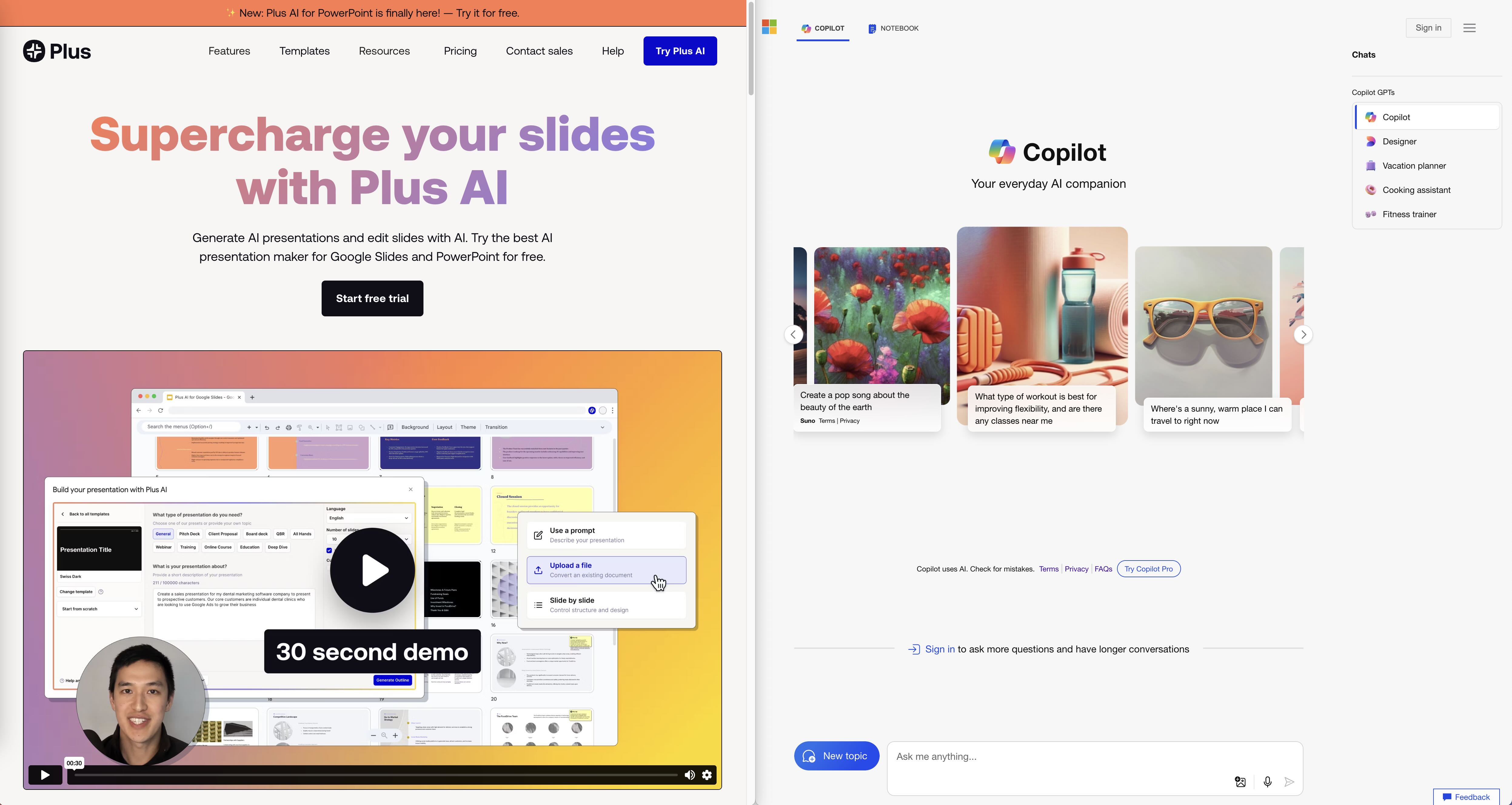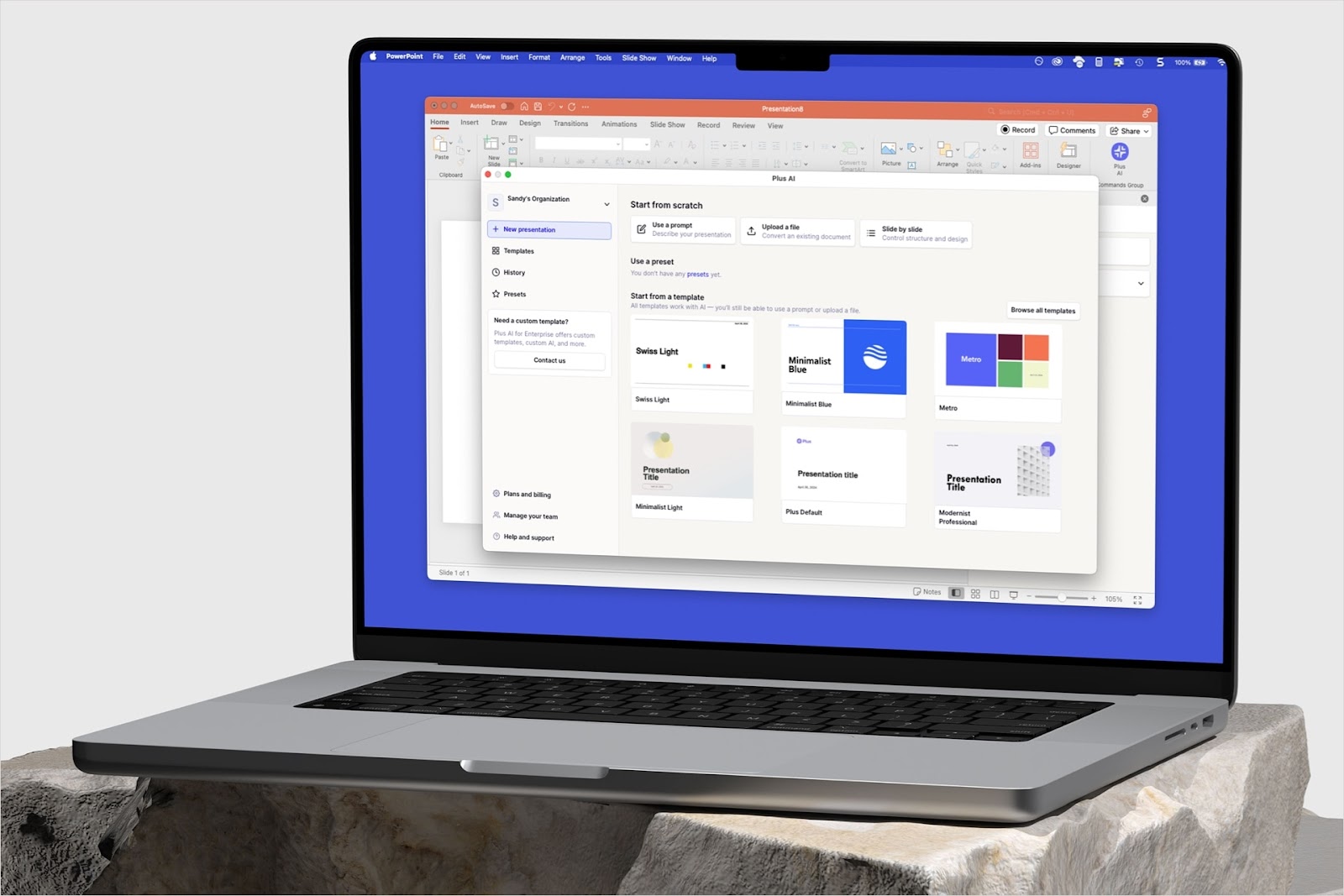AI tools and large language models can save you a lot of time at work and school. But to get the most out of your AI tools, you need to understand how to write good prompts.
This guide will help you understand how to write good prompts for different types of AI tools and provide you with practical tips on how to become a great AI prompt writer. We'll also share examples of great prompts that you can use for your own projects.
{toc}
How to write AI prompts to generate presentations

Plus AI is an AI slide maker that helps customers create great presentations in seconds. Plus AI is optimized to help users convert simple text prompts into professional slide decks, so it is easier to use than an "off-the-shelf" AI chatbot.
However, there are still several ways you can improve your Plus AI prompts to make sure you are getting the best possible outputs. Here are some tips on how to write effective prompts for Plus AI to generate high-quality presentations:
1. Include context: Goal, audience, and other supporting information
Just like humans, AI tools perform best when the understand the context of what they are being asked to do. This includes key information like the goal of the presentation, the audience for the presentation, and other requests like tone, style, or supplemental data.
2. Be specific about the content and include requests for specific slides
When writing your prompt, be specific about the type of content you want. For example, you will get much better outputs if you can provide a specific prompt like "Create the slides for an online course about how to use deep breathing techniques" than a vague prompt like "meditation."
In addition to being specific about the overall content, you should also provide requests for specific slides. This could include requests like "include a case study slide" or "include a slide to share benchmarks with the client." By providing these instructions in your prompt, the AI tool will be able to create the exact presentation you need.
3. Use Plus AI’s tools to direct the AI
Because Plus AI is optimized for creating presentations, there are several features that can help you make sure you are getting the most out of the AI. When there are opportunities to use built-in features to control the AI outputs, make sure to use them rather than trying to do all of the work with your prompts.
For example, if you want to control the number of slides in the presentation, use the number of slides selector to specify the number of slides. If you'd like to create a slide deck from a longer article or blog post, use the "Text to presentation" mode rather than the standard prompt form.
4. Understand limitations around AI
Over time, AI will continue to improve and there will be fewer limitations, but it's helpful to understand when AI is "smart" and when it's dumb. Most of the AI models like OpenAI’s GPT-3 and GPT-4 are "trained" using public internet data from 2021. This means there are several types of information that it will not understand out of the box:
- News and events after 2021
- Private data that is/was not on the public internet
- Data / information that you have shared with the AI in the past
(Surprisingly, this means that many of the AI tools actually don't have a lot of context about the current generation of AI tools!)
If you would like to use Plus AI to create a presentation on one of these types of topics, you should try copying and pasting information into Plus, so that the AI will be able to integrate that knowledge into its outputs.
5. Use this formula: Create a [type of presentation] about [ topic ] for an [audience]. Include a slide on [slide request]
This formula is a great starting point when writing your Plus AI prompts because it ensures that you include all of the necessary information for Plus AI to generate great outputs.
For example, if you want to create an overview about marketing automation for an executive audience of prospective customers, you could use the following prompt: "Create a webinar presentation about marketing automation for executives at food and beverage companies. Include a case study slide on the ROI of marketing automation at our largest customers."
You could make this prompt even more specific by adding instructions like, "The goal of this presentation is to convince the executive team to invest more in new marketing software" or "Write this presentation in the style of a McKinsey management consultant."
Examples of great prompts for Plus AI presentations
Plus AI has several preset prompts that can get you started with your presentation, but here are some more examples if you are looking for inspiration from our community of users.
Create a presentation on opportunities to use ChatGPT at [your company name], [a web design agency focused on clients in the healthcare industry]
Analyze the market landscape for [car wash software] and create a launch strategy for a new startup that helps car washes increase subscription revenue
Create the slides for a training course on how to use ChatGPT and other AI tools as a [marketing manager]. Include tips on what to emphasize on each slide.
Create a slide deck for a new dad on how to take care of babies. Include tips on how to take cute baby photos and maximize sleep.
Create a sales deck for Plus, an enterprise software company, to sell AI presentation tools to Pacific Bank, a bank serving high net worth customers in Seattle.
Include a case study on how Atlantic Bank uses Plus to create market updates and educational materials for customers.
Convert this blog post into slides that can be shared as educational content with prospective customers:
[copy and paste a blog post here]
Summarize this article in a presentation to share with my customers in a market update
[copy and paste this article from WSJ.com]
Create a deck on the Messi Effect in US: the impact Lionel Messi is having in the US Soccer League. The deck should go over a brief intro on Messi and all the accomplishments he’s had over the years prior to joining the MLS.
The deck should go over the details of Messi’s deal on signing with Inter Miami and forgoing joining the Saudi Arabia’s league which would have been a more lucrative choice for him.
Having joined the Inter Miami team he has instantly changed the team’s poor win rate. There should be a slide that shows the win rate before and after Messi joined the team.
Create an educational presentation for college students on the essentials of interior design. Include a slide on the proper size and placement of rugs and another one on the proper size and placement of curtains.
Create a pitch deck for McDonald's Business Model, include the history, marketing strategies and franchise model
Create a pitch deck for Chipotle Mexican Grill explaining why it's a healthy option that can adjust to many different types of dietary restrictions and diets, and why the build-your-own kids meal is a great hack
{cta}
How to write AI prompts for ChatGPT and other AI applications
ChatGPT and other AI tools are a very open-ended way to work with AI, and it can take a bit more work to get useful outputs because you need to be more specific and put more work into creating effective prompts.
In order to get the most out of them, follow these best practices for writing effective prompts:
1. Create clear instructions with specific intents and goals
AI tools work best when they receive specific instructions on what they need to do. Because they are predicting their responses word by word, the more specificity you can give them upfront, the better their outputs will be.
The main things to make sure you include in any prompt are intent (what are you trying to do) and goals (what a good output looks like). After, making sure the AI can get the general gist of your request, then you can start optimizing your prompt to make the outputs even better.
2. Create step-by-step requests to help let the AI "think"
One of the best ways to getter high-quality results from AI is to give the AI time to "think." The easiest way to accomplish this is to include "thinking" instructions in your prompt. For example, if you are asking the AI to solve a math problem, you should ask it to explain its work step by step.
For more complex processes and workflows, you can even include a step-by-step process guide in your prompt and ask the AI to follow it to produce your output. For example, "You will be asked to extract important data from this article: First, save the name of the author. Then read the first paragraph to determine the primary topic of the article. Next, analyze the tone of the first paragraph to determine the sentiment of the article...."
3. Use delimiters to direct the AI
Humans often use fonts, formatting, line breaks, and other visual hints to understand the significance of different parts of an article. To help AI understand the different input types from an instruction use "machine language" (a.k.a. delimiters) to mark breaks in the input formats.
For example, you may want to mark the end of user instructions and the start of examples for the AI. You can use symbols like ''' """ or <> before and after your text to create distinct sections for your prompt.
4. Provide examples
The best way to train AI to understand what you want is to just show it what you want. If you can provide some examples of good outputs for a set of inputs in your prompt, your AI will do a much better job of predicting what you want the next time you put in a new input.
One thing to watch out for when providing examples is to ensure there is a varied set of inputs and outputs, so that the AI picks up on the right signals from your examples, rather than just producing the same output every time.
5. Use the RGIO formula: Role + Goal + Input + Output
You are a [role]. Your goal is to help [type of user] [accomplish a certain task]. You will be given [type of input] and asked to create [type of output]. Here is an example: Input: [example input] Output: [example output]
Using this formula is a great way to ensure your prompts are clear and will get you a good output from the start. To improve on this, you can provide more 'step-by-step' requests, change the specific words for roles, the task, and better examples.
Examples of great prompts for ChatGPT and other AI applications
- Sales - You are the world's best sales copywriter. Your business is [name of business] and you sell [name of product], a [description of product]. Write a 200-word [Facebook post/email] that will persuade [customer type] to buy your product
- SEO content - You are a professional SEO content writer. Your business sells [types of product]. Your job is to create a list of 10 ideas for new blog posts that will help us find more customers for our product
- Interview prep - I am interviewing for a [role] at [healthcare company]. You are my future manager, and you are interviewing me for the role. You will ask me a 5 questions to assess if I am a good fit for the role, and I will provide responses. At the end of the interview, you will provide feedback on my answers.
- Personal assistant - You are an AI assistant that helps readers quickly understand news. Summarize this article in two to three sentences.
- Strategy consultant - You are a strategy consultant who is helping [startup name] launch a new product. Help create a sales and business development strategy to market this product to new customers in [region]. Think step-by-step and present a 90 day plan for the launch.
Conclusion
Writing AI prompts can be tricky, especially when you don't get great results right away. However, continuing to practice and following the best practices in this article can help you create better prompts and better AI outputs
Remember, writing prompts is an iterative process that involves a lot of trial and error. As you continue to work on more prompts, you will get better at revising and improving prompts over time.







